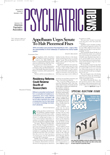A seven-item screening instrument for hospitalized patients with medical conditions appears to be useful for identifying patients who require a psychiatric evaluation.
The Cornell Psychiatric Screen assesses psychiatric conditions, including cognition and behavior problems, depressive symptoms, anxiety, drug and alcohol history, and desire to see a psychiatrist.
Of the patients whose results on the screen indicated possible psychopathology, 89 percent had documented psychiatric comorbidity, according to DSM-IV criteria.
A report on the screening instrument appeared in the October Psychosomatics.
“The scale is brief and easy to administer, and demonstrated good test-retest and interrater reliability,” study co-author Stephen J. Ferrando, M.D., told Psychiatric News. “Ninety percent of the patients who screened positive had a major Axis I psychiatric diagnosis.”
Ferrando is an associate professor of psychiatry at the Weill Medical College of Cornell University in New York City and director of the psychiatric consultation liaison service at New York–Presbyterian Hospital.
He added that the absolute score on the Cornell Psychiatric Screen correlated with length of stay—“a measure of face validity in that it has been previously demonstrated that psychiatric comorbidity increases length of stay,” he said.
The questionnaire was developed and tested in four phases: selection of candidate items, test-retest reliability, selection of final items, and validation. After the scale was developed, its properties were tested among three independent cohorts of patients. All were adult patients admitted to the internal medicine service of the New York–Presbyterian Hospital.
In the first phase, a team of psychiatrists with expertise in consultation-liaison psychiatry, mood disorders, schizophrenia, and geriatric psychiatry was convened. This team selected items that pertained to psychiatric symptoms or disorders commonly encountered among medical inpatients.
In the second phase (test-retest reliability), a questionnaire was developed from the items generated and was administered on two occasions to 106 patients on the medical service. A statistical test was used to determine reliability of items between the test and the re-test.
In the third phase, another independent cohort of 299 patients was recruited and was administered the questionnaire by nonmental health research assistants. A team of psychiatrists was given an abstract of the patients’ charts with information from the questionnaire embedded (but not identified as being from the questionnaire) in the abstract.
On the basis of the abstracts, the team of psychiatrists rated whether the patient needed psychiatric evaluation using a 5-point Likert scale: definitely needed, probably needed, uncertain, probably not needed, and definitely not needed. The questionnaire items were then analyzed using statistical methods to determine which were significantly associated with “definitely needing” psychiatric evaluation.
In phase four, another group of 206 patients was administered the screen. An independent psychiatrist from the consultation-liaison service who was blinded to the outcomes of the study evaluated all patients who scored 2 or more on the screen (indicating possible psychopathology), using DSM-IV criteria.
In that final stage, 44 patients scored 2 or more on the screening instrument. Of these, 39 (89 percent) had a documented DSM-IV diagnosis, according to the report in Psychosomatics.
Ferrando said there are not many reliable tools in use for screening hospitalized medical patients. “Most of them are geared toward outpatient primary care settings,” he said. “They are more lengthy and often do not assess the full range of disorders seen, nor do they query patients as to whether they would like an intervention.”
He added that the screen takes under five minutes to administer and can be easily integrated into the usual admission nursing assessment.
Constantine Lyketsos, M.D., who is chair of the APA Corresponding Committee on Psychosomatic Medicine and reviewed the study for Psychiatric News, said the Cornell screen appears to be a promising tool for assessing psychiatric comorbidity among hospitalized medical patients.
“I think it is a valuable tool that could be used,” said Lyketsos, a professor of psychiatry and behavioral sciences and co-director of the division of geriatric psychiatry and neuropsychiatry at Johns Hopkins University School of Medicine in Baltimore. “The challenge is whether it will be of use in terms of actually getting people referred for the help they need.”
Lyketsos said such screening devices are not typically in use, because “screening implies that you do something” when people screen positive. Because mental health is frequently carved out of private health insurance plans, reimbursement is often lacking for psychiatric treatment of medically ill inpatients.
“We haven’t persuaded our colleagues in internal medicine that screening for psychiatric disorders really makes a difference to their patients,” Lyketsos said. “We need to raise the awareness of the existence of comorbidity and the effect that psychiatric illness has on the primary medical condition.”
Ferrando noted that New York Presbyterian Hospital funded the study. “The primary motivation came from a mutual agreement between the department of medicine and psychiatry that psychiatric comorbidity is a real problem in terms of outcomes and hospital costs.
“Surprisingly few hospitals are doing this type of screening and linking it to psychiatric intervention,” Ferrando said. “As consultation-liaison psychiatry becomes a subspecialty known as psychosomatic medicine, such integrated psychiatric screening and intervention will hopefully become more mainstream.”
Psychosomatics 2003 44 382
